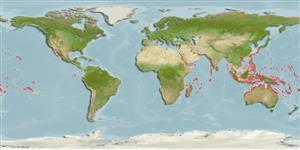分类 / Names
俗名 | 同种异名 | Catalog of Fishes(属, 种) | ITIS | CoL | WoRMS | Cloffa
Teleostei >
Eupercaria/misc (Various families in series Eupercaria)
鱸形目 (Various families in series Eupercaria) >
Labridae (Wrasses)
隆頭魚科 (Wrasses) > Corinae
Etymology: Thalassoma: Greek, thalassa = the sea + Greek, soma = body; the colour of the sea (Ref. 45335).
More on author: Forsskål.
Environment: milieu / climate zone / depth range / distribution range
生态学
海洋 礁区鱼类; 深度上下限 0 - 10 m (Ref. 30573). 热带; 32°N - 32°S
Indo-Pacific: Red Sea and East Africa (Ref. 4392) to the Hawaiian, Marquesan, and Easter islands, north to southern Japan, south to Lord Howe, Kermadec, and Rapa islands. Southeast Atlantic: southeast coast of South Africa (Ref. 4392). Replaced by Thalassoma virens in the Revillagigedo Islands (Ref. 37816).
印度-太平洋: 红海与东非 (参考文献 4392) 到夏威夷,马贵斯群岛与复活岛, 北至日本南部, 南至罗得豪岛,克马得群岛与拉帕群岛。 东南大西洋: 南非的东南海岸.(参考文献 4392) 在雷维拉吉哥多岛中被 绿锦鱼〔Thalassoma virens〕 取代了。 (参考文献 37816)
大小 / 重量 / 年龄
Maturity: Lm ? range ? - ? cm
Max length : 46.0 cm TL 雄鱼/尚未辨别雌雄; (Ref. 30573); 最大体重: 1.2 kg (Ref. 40637)
背棘 (总数) : 8; 背的软条 (总数) : 12 - 14; 臀棘: 3; 臀鳍软条: 10 - 12. T. purpureum and T. trilobatum have nearly identical initial phases (Ref. 1602). They differ slightly in details of the head markings, and T. purpureum has a slightly longer head, shorter pectoral fins, and attains a larger size (Ref. 1602, 48636). Females best distinguished by the 'V' mark on the snout (Ref. 48636). Initial phase with a vertical dark red line below front of eye usually with a branch to front of snout (Ref 9823).
T. purpureum 与 T. trilobatum 有几乎同一的起始时期。 (参考文献 1602) 他们在头部斑纹的细节差异很小,而且 T. purpureum 有一个些微比较长的头部,较短的胸鳍, 而且达到一个较大。 (参考文献 1602,48636) 雌性最好在吻部上藉着 'V' 标志区别了。 (参考文献 48636) 初期阶段有一条垂直的暗红色线前方下面眼通常有对吻部前面 (参考文献 9823) 的一个分支.
Found almost exclusively in the surge zone of outer reef flats, reef margins, and rocky coastlines, down to a depth of about 10 m (Ref. 5213). Benthopelagic (Ref. 58302). Occur in groups of females that are spread out over large reef sections and dominated by few males. Males grow much larger than females (Ref. 48636). Feed on small invertebrates (crabs, sea urchins, brittlestars, mollusks), small fishes, echinoids, ophiuroids and polychaetes (Ref. 37816). Protogynous (Ref. 55080).
几乎只在外礁平台,礁区边缘与岩石的海岸线的涌浪区中发现, 向下至深度大约 10 公尺.(参考文献 5213) 出现成群母鱼那是散开的大范围礁石之上而且被少数雄性控制。 雄性长得比雌性大很多。 (参考文献 48636) 吃小型无脊椎动物 (螃蟹,海胆,阳燧足 , 软件动物) ,小鱼,海胆,阳燧足与多毛类动物。 (参考文献 37816) 雌性先熟的.(参考文献 55080)
Life cycle and mating behavior
Maturities | 繁殖 | Spawnings | Egg(s) | Fecundities | 仔鱼
Pelagic spawner.印度-太平洋: 红海与东非 (参考文献 4392) 到夏威夷,马贵斯群岛与复活岛, 北至日本南部, 南至罗得豪岛,克马得群岛与拉帕群岛。 东南大西洋: 南非的东南海岸.(参考文献 4392) 在雷维拉吉哥多岛中被 绿锦鱼〔Thalassoma virens〕 取代了。 (参考文献 37816)
Randall, J.E., G.R. Allen and R.C. Steene, 1990. Fishes of the Great Barrier Reef and Coral Sea. University of Hawaii Press, Honolulu, Hawaii. 506 p. (Ref. 2334)
人类利用
渔业: 低经济; 游钓鱼种: 是的; 水族馆: 商业性
工具
特别资料
下载 XML
网络资源
Estimates based on models
Preferred temperature (Ref.
123201): 24.6 - 29.3, mean 28.3 °C (based on 3134 cells).
Phylogenetic diversity index (Ref.
82804): PD
50 = 0.5000 [Uniqueness, from 0.5 = low to 2.0 = high].
Bayesian length-weight: a=0.00955 (0.00430 - 0.02123), b=3.06 (2.89 - 3.23), in cm total length, based on LWR estimates for this Genus-body shape (Ref.
93245).
营养阶层 (Ref.
69278): 3.8 ±0.0 se; based on diet studies.
回复力 (Ref.
120179): 中等的, 族群倍增时间最少 1.4 - 4.4年 (Preliminary K or Fecundity.).
Fishing Vulnerability (Ref.
59153): Moderate vulnerability (36 of 100).
Nutrients (Ref.
124155): Calcium = 42.4 [25.2, 69.5] mg/100g; Iron = 0.532 [0.303, 0.984] mg/100g; Protein = 18.8 [15.9, 21.1] %; Omega3 = 0.118 [0.076, 0.185] g/100g; Selenium = 23.1 [13.7, 42.7] μg/100g; VitaminA = 105 [31, 372] μg/100g; Zinc = 1.25 [0.88, 1.92] mg/100g (wet weight);
